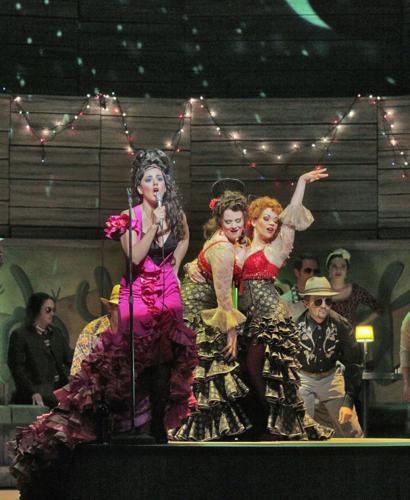Santa Fe Opera opened its 58th season on Friday evening with an entertaining new production of one of the art form’s most dependable warhorses, Georges Bizet’s Carmen. The piece has figured in seven of the company’s seasons, a statistic that accurately reflects the work’s global ubiquity, and directors have stretched it this way and that in their efforts to keep it fresh and relevant. In its two most recent outings here, it was given as a more-or-less standard Spanish Gypsy-and-bullfighter drama (in 1999) and as drab, Franco-era social commentary (in 2006). In this year’s production, director Stephen Lawless sets the action around 1960 somewhere along the Mexican-American border, where Carmen’s cohorts are smuggling (and snorting) cocaine. You don’t have to invest much thought in this, though; as with so much in the production, ideas are superimposed lightly on the piece’s framework rather than worked deeply into its texture. One had no reason to imagine the opening scene was taking place anywhere but Spain (which is where the librettists set this opera), and placing the action in our hemisphere rather than Bizet’s seemed to matter little.
The production makes striking use of black-and-white film clips, some vintage (I assume), others newly shot but in a similar style. These set the scene vividly and expand the perspective beyond what would be possible through stage action. The clips are well selected and might be still more effective if they were used more sparingly, but they will help hold the audience’s attention in an era addicted to broadcast images. They alleviate the modern opera director’s horror of allowing instrumental music to be heard unaccompanied by stage action. Carmen is famously shot through with such orchestral expanses, including some of the most ravishingly beautiful such bits in the entire operatic repertoire, but I doubt that anybody listened to them much on Friday as they were demoted to the role of film soundtrack. Not that the orchestral playing was always top-notch, but for the most part conductor Rory Macdonald kept things moving efficiently and coordinated the stage and the pit reasonably well, though without seizing opportunities for special moments.
The singing was likewise quite good — indeed, good enough to add up to an enjoyable outing. Vocal aficionados may feel, however, that the principals’ vocal strengths did not invariably align with the roles they interpreted. In the title part, Daniela Mack provided a mezzo-soprano’s range but not the tonal luxury, let alone the sultry or fiery qualities, one reasonably expects in the portrayal of this troubled temptress. Even her Séguedille was more admirable for the clarity and definition of her singing than for any seductive qualities. Hers was on the whole a girlish Carmen and, although her obvious vocal ability may lead her to a fine career, Carmen may not become one of her signature roles. She did, however, trump the rest of the cast in one critical area: her spoken French was excellent and expressive. This was far from incidental in that the opera was given with some of the dialogue spoken, as Bizet and his librettists wrote it, rather than with the sung recitatives that replaced the spoken portions for a production shortly after the composer’s death. The spoken-dialogue version is not often encountered today, and it provided effective dramatic momentum, offering a seamless flow among full musical treatment, speaking over a musical accompaniment (melodrama), and stage-play declamation.










